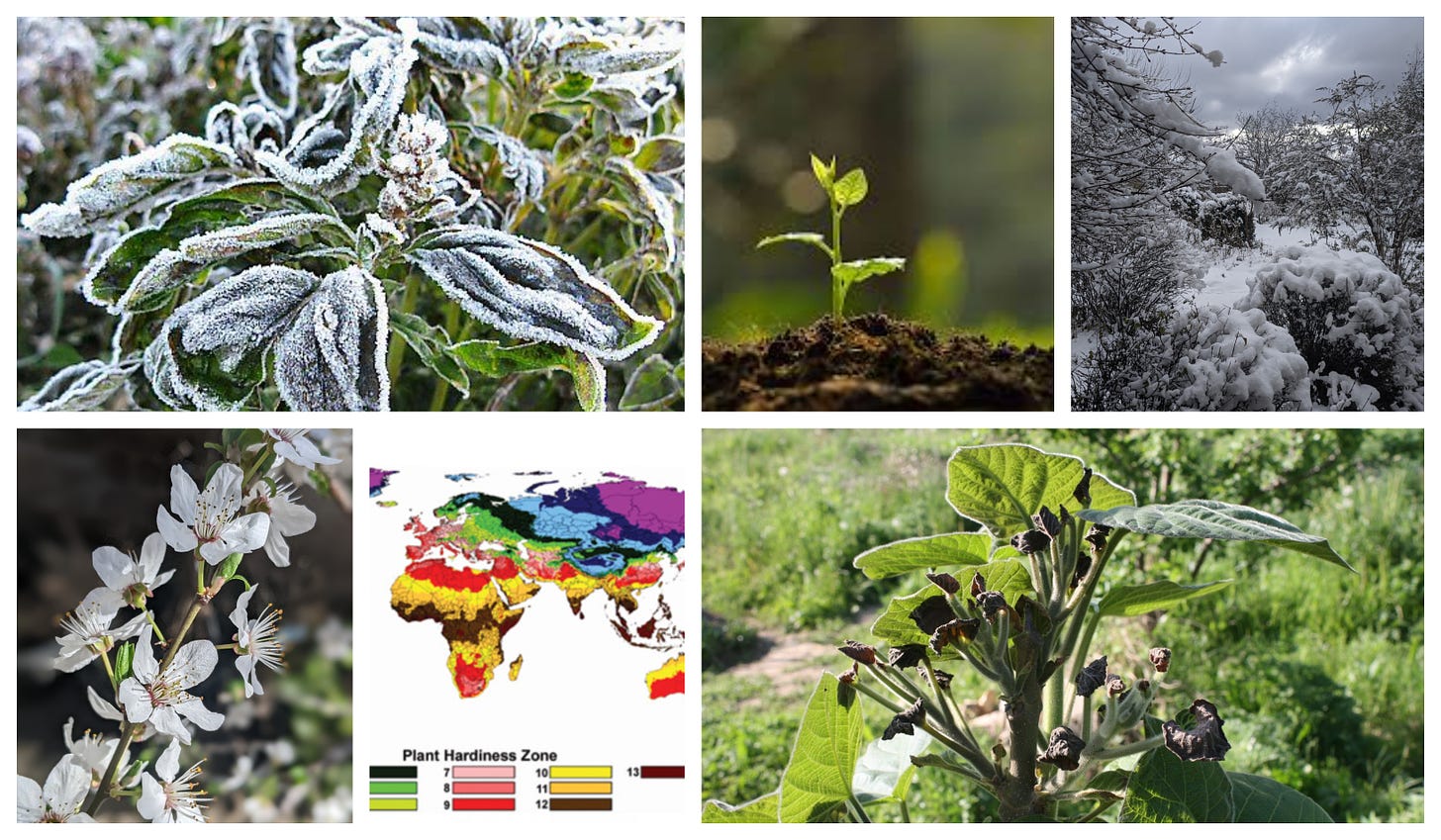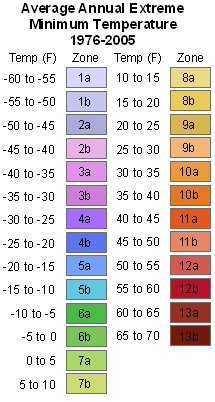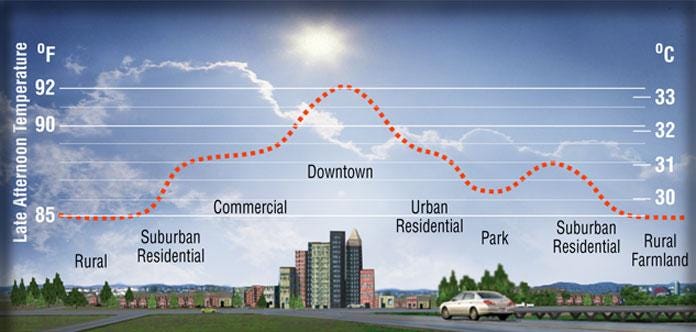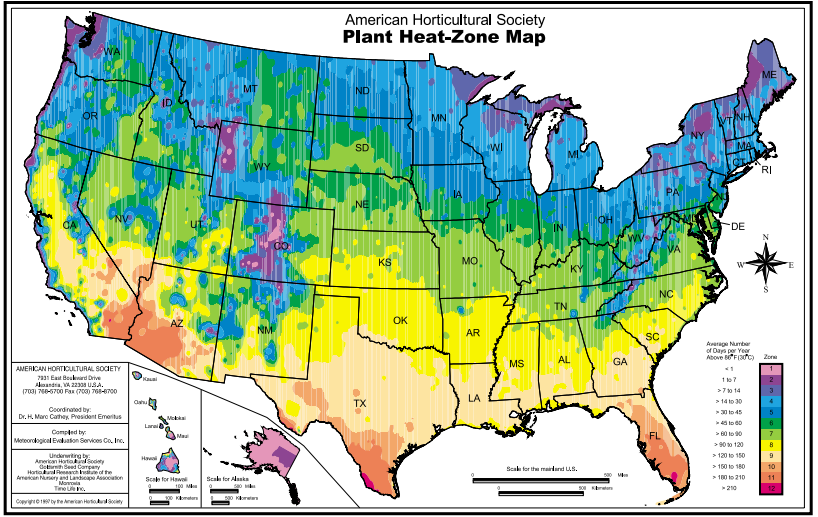Throughout this post, we will explore the concept of plant hardiness and its corresponding hardiness zones—a vital variable in the realm of cultivation
Plant hardiness and hardiness zones
A plant must be able to survive the lowest temperature during winter in the place that they are growing in order to survive for the next growing season, and every plant has a threshold temperature below which they will die. The ability of a plant to survive extreme cold temperature is referred to as its hardiness. A very hardy plant is able to tolerate extreme lows while a non hardy plant cannot tolerate cold temperature at all.
Temperature is well recorded across the world and hardiness zone maps have been created that show what areas experience what temperature ranges. There are a number of different hardiness systems available, but the one I refer to in this book, and the one most commonly referred to, is the USDA Plant Hardiness Scale. The hardiness scale ranges from 1a to 13b, 1 being arctic conditions and 13 being tropical.
Observations of which plants can survive in low temperatures based on wild plants, and on trial and error experimentation by humans growing plants in various locations, is also well documented and as such, every plant has been assigned a hardiness rating that is provided in all good plant catalogs, books and internet databases.
For example Siberian pea tree - Caragana arborescens is given a 2b-7b rating that tells us that the plant will grow in hardiness zone 2b - 7b, which means it’s okay in areas that experience winter low temperature of -45 (F), but that it will not survive in Zone 1a - 2a where the temperature falls below -45 (F). It also tells us that the plant will grow in Zone 2b, 3, 4, 5, 6 and 7 but that it will not grow well in zones 8 to 13, probably due to it being too hot or humid for the plant in these zones.
The hardiness rating is not set in stone and it’s fine to experiment with plants a few zones outside of your hardiness zone, especially with plants grown from seed as genetic diversity often leads to individual plants with higher thresholds of cold tolerance. I have had a reasonable degree of success doing this for a number of species. Even when I’m buying plants I’ll try plants in higher zones at least twice before I’m convinced they won’t make it.
Local conditions such as altitude and topography should also be considered. For example, on most hardiness zone maps it shows our location 6b/7a, however our particular gardens are 580 meters above sea level and can experience very strong winds that result in winter lows of -13 F (-25 C), so we are effectively 5b. Micro-climatic factors within a garden can also provide differing conditions for plants. Planting areas by a south-facing wall will retain higher temperatures due to sun exposure and thermal mass while a low lying area along a north-facing wall will be colder and vulnerable to deep freeze. It’s also worth noting that urban and suburban areas are usually a few degrees warmer than rural areas.
Heat zones
Cold isn't the only factor determining whether plants will survive and thrive. Heat also has an impact on plants. Less obvious than the damage caused by cold, heat damage can nonetheless be detrimental to plants. Damage includes flower buds withering, leaf drop, chlorotic leaves, stunted root growth and a general weakening of the plant which lowers its defenses and makes it more attractive to insect pests and microbial parasites. Plant death from heat can be slow and lingering.
The AHS have created a Plant Heat Zone Map that divides America up into various zones based on the average number of days each year that a given region experiences ‘heat days – temperatures over 86 F (30 C). That is the point at which plants begin suffering physiological damage from heat. The zones range from Zone 1 (less than one heat day) to Zone 12 (more than 210 heat days). Thousands of garden plants have now been coded for heat tolerance, with more to come in the near future. Currently heat zone maps are only available in the US.
Regenerative Landscape Design - Online Interactive Course
Want to learn how to design, build and manage regenerative landscapes? Join us on our Regenerative Landscape Design - Online Interactive Course. We look forward to providing you with the confidence, inspiration, and opportunity to design, build and manage regenerative landscapes, gardens, and farms that produce food and other resources for humans while enhancing biodiversity.
You can find the course details here and at the moment we have a $300 ( 20%) discount for full enrollment to the course. Just use RLD2024 in the promo code section of the registration form to receive your discount.
Support Our Project
If you appreciate the work we are doing you can show your support in several ways.
Become a member of the Bloom Room. A $70 annual or $7 per month subscription to our Substack provides you with access to live sessions, design tutorials, a members forum and more, see details here.
Make a purchase of plants or seeds from our Nursery or Online Store
Joining us for one of our Practical Courses or Online Courses
Comment, like, and share our content on social media.
If you appreciate the work we are doing you can show your support in several ways.
Become a member of the Bloom Room. A $70 annual or $7 per month subscription to our Substack provides you with access to live sessions, design tutorials, a members forum and more, see details here.
Make a purchase of plants or seeds from our Nursery or Online Store
Joining us for one of our Practical Courses or Online Courses
Comment, like, and share our content on social media.
We offer a diversity of plants and seeds for permaculture, forest gardens, and regenerative landscapes including a range of fruit and nut cultivars. We Deliver all over Europe from Nov - March. - Give a happy plant a happy home :)
Welcome to our Online Store where you can find Forest Garden/ Permaculture plants, seeds, bulbs, and Polyculture multi-packs along with digital goods and services such as Online Courses, Webinars and eBooks. We hope you enjoy the store and find something you like. It's your purchases that keep our Project going.
You can also find our full list of trees. shrubs and herbs for forest gardens on our nursery website.
Want to learn more about Regenerative Landscape Design? Join The Bloom Room!
The Bloom Room is designed to create a space for more in-depth learning, for sharing projects and ideas, for seeking advice and discovering opportunities.
Ultimately, it aims to build a more intimate, interactive, and actionable relationship between members, a way for the Bloom Room community to support each other’s projects and learning journeys, and to encourage and facilitate the design, build, and management of more regenerative landscapes across our planet.
What you can expect as a member of the Bloom Room
As a member of the Bloom Room you can expect;
Access to an interactive forum where you can ask questions, direct what type of content you would like to see as well as share your own content and projects.
Monthly live session featuring general Q&A and tutorials on design software for creating and presenting polycultures.
Live session every month for members to showcase your projects, plans, designs, and gardens, with guest speakers from the community.
Full Access to all of the content on Substack
A 50% discounts on all of our online courses
Future opportunities to join our Global Regenerative Landscape Design and Consultancy Service, with potential roles for those with the will and skill to join our design team.
An opportunity to take part in the group ownership of a Regenerative Landscape. You will find more details on that here.
Become a paid subscriber to our Substack to join. The annual subscription is currently $70 and the monthly subscription is $7 (monthly subscription excludes discounts for products and services) . You can join here, we look forward to meeting you!











"I can't get enough of your blog! Your ability to break down complex ideas into easily understandable concepts is truly commendable. Looking forward to more enlightening posts!"
ReplyDeletehttps://www.discountdrift.com/promotions/
"Your blog is not just informative; it's a source of inspiration for aspiring [subject] enthusiasts like myself. Your personal anecdotes, shared experiences, and passion for the topic add a human touch that resonates deeply. Thank you for being a guiding light in my journey of exploration!"
ReplyDeletehttps://www.couponsstudio.com/all-stores